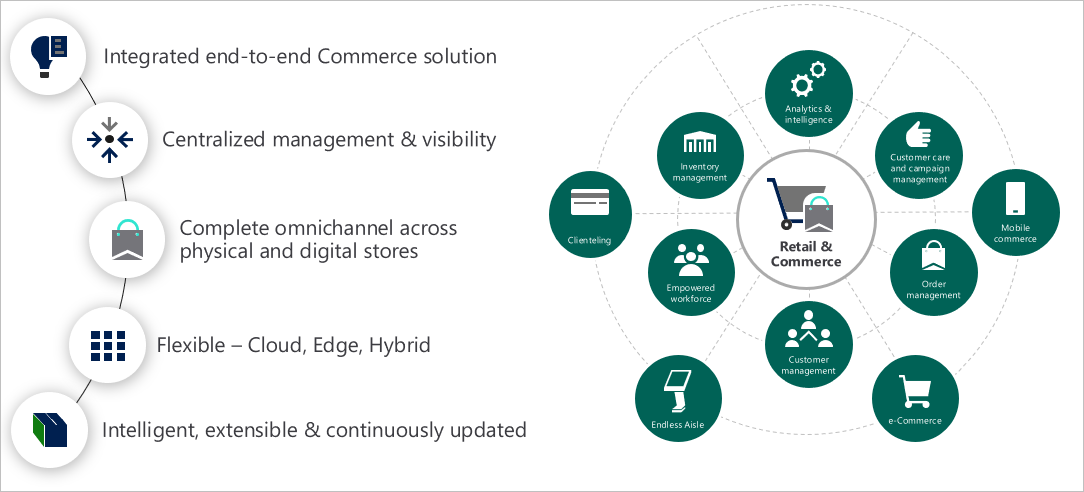Overview
The retail industry is one of the most dynamic, revolutionary industries. It must be as technologically savvy, knowledgeable, and discerning as its customers, who are creating ever-increasing expectations of retail service.
Unified commerce is a fundamental shift in how technology supports the retail business. With unified commerce merging front-end and back-end systems into a single platform, technology is no longer a set of standalone, separate entities. Instead, technology gives the retailer’s business a foundation and creates an agile system for delivering insightful, efficient service at every touchpoint.
When it comes to meeting and exceeding the expectations of customers, this is best done by identifying what needs they have and how to meet them. Using Commerce, customer insights can be tracked and recorded to deliver a unique experience for every person that interacts with your business. This is done by unifying back-office, in-store, and digital experiences into a single system that allows you to have a complete view of your business and your customers.
The following graphic shows an overview of Commerce capabilities and how they integrate with one another to create a complete picture of your business.
In the modern retail environment, consumers are well informed and expect intuitive, engaging, and informative experiences when they shop. This situation is referred to as connected commerce, which is best described as:
- Delivering great customer experiences with a true omnichannel solution.
- Allowing employees to deliver exceptional customer service.
- Strengthening strategic planning and merchandising practices.
- Integrating supply chain in all touchpoints.
- Unifying business processes across every channel.
The following illustration shows how Commerce capabilities support the modern customer journey.
Successfully implementing Commerce can provide immersive customer experiences across all touchpoints and be scaled to your needs across traditional and emerging channels. Below are a few of the ways that this can specifically be achieved in Commerce.
Build and run digital commerce
Built-in web authoring and development tools help you create engaging and intelligent digital storefronts. Connecting with Dynamics 365 Customer Insights - Journeys creates an integration of assets, promotions, inventory, and pricing across all channels that can be used to reach specific customer segments. Through the intuitive Site-builder tool that is available in Commerce, custom content can be created for a large variety of customer segments and channels using real time data. Specific site content can be marketed and shown based on customer insights that are gathered from metrics such as Geo-location to further help with customer segmentation and targeting.
More information on using the Site builder tool for your E-commerce site, see Create online presence in Dynamics 365 Commerce.
Below is an example of what a website that has been developed for Commerce may look like from a customer's point of view.

Build loyalty and exceed customer expectations
One of the primary ways Commerce can be used to exceed customer expectations is in providing tailored experiences to every customer. Through product selection suggestions and relevant recommendations, a customer can enjoy a personalized buying experience that focuses on meeting their needs. By making the process seamless for a customer to check-out, whether they are buying online or in-store, will empower customers to bring their business to you and help build brand loyalty.
Providing a unique buying experience can be enhanced when combined with other Dynamics 365 apps such as Dynamics 365 Customer Insights - Journeys, which supports the management of content, assets, promotions, inventory, and pricing across channels.
Streamline operations with cloud intelligence
Daily operations can be enhanced through the usage of the Store Commerce app and AI-driven recommendations. Using these tools can allow for making cost-effective inventory supply decisions as well as targeting the right products to the right customers at the right time. Cloud intelligence is important for helping maintain organization in a Commerce operation and getting real time data to support important business decisions.
With Commerce, you can centrally track product information, assortment, categories, and pricing across all channels and by using AI insights, you can accurately forecast customer demand based on these metrics. This intelligence helps you to continuously adapt to changing business needs, and improve the overall quality of service and customer satisfaction.
Microsoft Clarity
With Microsoft Clarity enabled, you can seamlessly adjust site content real time as insights that relate to customer interaction come in. With the data that is coming into Microsoft Clarity, a visual representation will easily be able to show how a customer responds to different web pages. Combined with Commerce, Clarity provides a clear view of how an end user interacts with an E-commerce site.
Go to the Microsoft Clarity to learn more.
Extensible, dependable, secure, and compliant
Flexible deployment options allow you to meet your business needs, supplying highly extensible and adaptable rollout options. Dynamics 365 adheres to global compliance and security standards.
Next, you will review some key features of Commerce.


